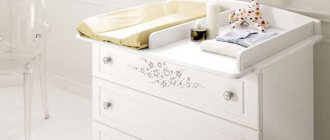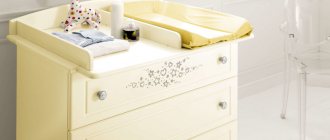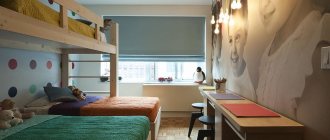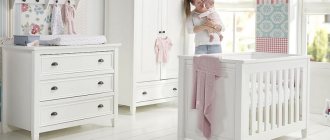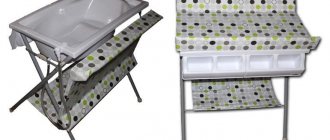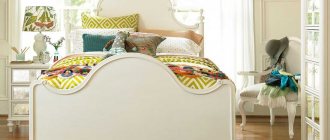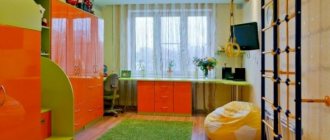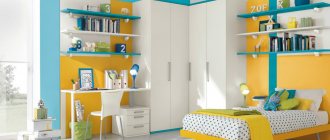19670
Any parent wants to create optimal conditions for growth and development for their child. To simplify the process of caring for a baby, a lot of furniture is produced, which includes a chest of drawers with a changing table for newborns, produced in different colors and has optimal sizes. It is important to know what types of changing chests exist and how to correctly choose the optimal model that is safe and convenient to use.
Why do you need a changing table?
Before the birth of a child, future parents have to resolve many issues, make a lot of purchases and preparations. In the general whirlwind of endless acquisitions, the thought of possible savings involuntarily creeps in. But to the question of whether a family that will soon have a baby needs a changing table, there can be only one answer - of course it is needed. Only at first glance it may seem that you will only be changing the baby on the changing table or chest of drawers, and this will take a couple of minutes. And this process will last less than a year. For some, the use of a changing table or board ends before the baby reaches six months of age. But even this period is several months of constant use. On the changing table you will not only change the baby's clothes, but also do gymnastics and massage, clean the nose, ears and trim nails, treat the baby's delicate skin and carry out many other procedures and even games.
If we imagine that all these actions will need to be performed several times a day, not on the plane of a changing table or carrying board that is convenient for the mother’s growth, but on a bed or sofa (depending on the layout of the children’s room or the lack of a separate room for the baby), then it becomes It is clear that no back can withstand such a load. So, a changing surface is necessary, any experienced parent can convince future mothers and fathers of this. Let's consider variations of creating a comfortable, safe and ergonomic place for changing (and not only) a baby.
Popular models
The difference between a changing chest and a regular one is the presence of a place on the top surface for child care. The classic model is equipped with a built-in table and drawers. Designs can be of two types - overhead and folding. Manufacturers often produce changing chests with an extension, open shelves, side niches, a bathtub, and wheels for ease of movement.
As a rule, a waterproof mattress with soft padding made of hypoallergenic materials is included with the changing board. The main disadvantage of a built-in board is the limited functionality of the chest of drawers. Accordingly, the furniture will lose relevance when the child grows up.
With overhead table
The soft changing board for the chest of drawers is a separate element. It is placed on the top cover of the furniture while caring for the child, and then it can be removed and put away. The design of the cover allows it to be installed without any fastenings. Such a board is usually supplemented with protective sides and a soft, waterproof lining.
If the nursery already has an ordinary small cabinet, it can be supplemented with a self-made table cover. To complete the task, you will need high-quality lumber and well-constructed product drawings. If a person has extensive experience working with wood, even making an entire changing chest with his own hands will not cause him any difficulties.
The model with an overhead board is more practical than other options. The table can be easily removed, and the chest of drawers can continue to be used even when the child has grown up.
With folding table
The folding surface folds in half at the top of the cabinet, that is, the dimensions of the furniture are not tied to the size of the changing area. When unfolded, the table protrudes slightly beyond the top lid of the chest of drawers, allowing you to comfortably place a child and all the necessary care items on it. When there is no longer a need for a changing area, the folded board can be used as a shelf or you can remove the fastenings and put it away completely, turning the children's chest of drawers into a regular linen closet.
Original designer chests of drawers, a combination of convenience and aesthetics
With hinged lid and built-in bath
Changing chests with a bathtub are suitable only for the youngest children. As a rule, such models move on wheels to make it convenient to use the furniture anywhere in the apartment. For example, if you have a spacious bathroom, you can move the chest of drawers there for bathing time, or move it to the middle of the room for the convenience of parents and to protect the walls from accidental splashes.
When a chest of drawers with a changing table is placed in a permanent place, the wheels must be blocked to eliminate the possibility of injury to the baby as a result of accidental movement of the furniture during hygiene procedures.
There are two options for the location of the bath:
- below under the folding changing board;
- in the form of a retractable structure.
In the first case, you will have to lift the hinged lid to access the tub, and then lower it again when it is time to dry and change the baby. It is difficult to perform all these manipulations alone. A pull-out bathtub is much more convenient. After washing, the baby is simply transferred to the table, where everything is ready to be dressed. This model of chest of drawers is convenient for bathing, but collecting and draining water is quite difficult, especially if water procedures take place in the living room. You will have to use buckets or hoses - this is a significant disadvantage of the product.
Transformers
A transforming bed with a chest of drawers is a multifunctional design. Depending on their height, a child can use it up to 8 years old. Initially, the baby sleeps in the cradle, and the chest of drawers is attached to it at the head or feet. When the child turns 3–4 years old, the bedside table is disconnected from the bed, placing these pieces of furniture separately. You can continue to use the bed, the only caveat is that you will have to purchase a new mattress, since the size of the sleeping surface will increase.
There are transformer options in which the chest of drawers folds out into a desk or is disassembled into separate elements: a bedside table, hanging shelves. Both designs are convenient and functional, but the second type is much more expensive. However, it will last much longer as a storage space, a table for games and activities, shelves for small items and toys.
Assortment of changing chest models
Now the furniture industry is so developed that there are changing chests for every taste and budget. Among all the variety, even the most demanding buyer will be able to choose a product to his taste.
The simplest design is a regular changing chest, which is equipped with a changing table at the top and has several drawers or a niche at the bottom. Everyone has seen such options in children's clinics and hospitals. But manufacturers are trying to take into account the wishes of parents in purchasing multifunctional furniture, so they offer the following options for purchase of such furniture items:
Chest of drawers with removable changing table. This is a very convenient model for use in the first months after the birth of the baby for various manipulations. Subsequently, when the child grows up, the changing board on top is simply removed and the furniture turns into a very ordinary chest of drawers for storing things.
Product with a hinged lid. This mechanism allows you to assemble the changing table when it is not in use for its intended purpose. This allows you to compactly place the chest of drawers even in a small room. Interior parts can be placed on top of the lid, and in a niche under it there is an opportunity to store hygiene items for caring for the baby.
Chest of drawers as part of a bed. Nowadays, we often find transformable beds that are equipped with a sleeping place and a changing chest, representing a single structure. But in size, such a composite chest of drawers is much smaller than its free-standing counterpart, since space is needed for the bed.
Transformable chest of drawers. This model implies the presence of a lid that can be conveniently lowered to the desired level so that the child, when he grows up, can use it as a desktop. This can also be used by adults when the furniture is not used for its intended purpose.
These are the main options for changing chests currently on sale. There are also a lot of additional options that greatly increase the functionality of these changing products:
- Wheels with a locking system that allow you to make a piece of furniture more mobile and move it to any convenient place right with your things. This will become an additional function when you need to clean or just get something you need.
- A system of closers on the chest of drawers, which allows you not to close them completely; this will happen automatically.
- Covering the changing table with stain-resistant materials.
- A changing table divided into several functional zones to accommodate the baby and all his accessories.
Important! Most of the wheels on dressers are made of silicone so as not to scratch the flooring in the house.
Standard sizes
On the changing surface, the baby can be positioned with its legs or side facing the mother. Models with a longitudinal table are narrower and more compact, but dressing the baby in this position is difficult. If you choose a chest of drawers with this arrangement, in addition to access to the front with drawers, you will have to provide free access to it from the side, which is not always convenient.
Manufacturers claim that standard changing chests are suitable for children under one year of age. The size of the space for performing hygiene procedures can be from 70 to 100 cm. A length of 70 cm is suitable for a six-month-old baby, but for an older child more space is needed. If possible, you should immediately choose a model with a surface length of 90–100 cm. The width of the board should not be less than 44 cm, the standard height of the fence sides is from 15.5 cm. The number of drawers ranges from 1 to 5.
Wide chests of drawers with a changing table, on which the baby is placed with his feet facing his mother, are much more convenient to use, but they take up more space. True, here you don’t have to worry about a free approach from the side. A compromise between these models is a narrow chest of drawers with a folding or overhead table, which protrudes slightly beyond the dimensions of the furniture. In this case, the dressing area allows you to place the baby with his legs facing his mother.
The best ways to restore a chest of drawers at home, useful tips
Folding surface parameters: 66–77 cm wide and 70–96 cm long. The changing area in transformable furniture is 61–66 cm. The standard height of children's chests of drawers is about one meter (95–105 cm). The height of the furniture should be selected based on the height of the mother: it should be comfortable for the woman to lay the baby down and care for him without straining her back.
In the most stable chest of drawers, the height from the floor and the depth are approximately the same.
Dimensions of models
For the convenience of using a chest of drawers for changing a baby, its tabletop must have certain dimensions so that the baby can fit on it at full height. If you plan to use a changing chest of drawers for up to a year, then a tabletop 70 cm long will be sufficient. If parents want to continue using this furniture, then you can choose the option with 90 cm. The height of the sides should be sufficient and is usually not less than 15.5 cm.
Built-in models of changing chests are limited to short lengths of the changing surface, which is usually similar to the width of the crib and varies from 68 to 72 cm. Manufacturers most often increase the width of the changing area by moving it outside the design of the chest.
There is no recommended height for a changing chest. Some manufacturers produce models from 88 to 92 cm. This furniture height is suitable for the mother’s short stature. If parents are slightly taller than average, then it is better to pay attention to products with a height of 94 to 98 cm. Less common are those chests of drawers whose height is 102 – 108 cm.
Regarding the depth of a baby changing chest, we can say that experts recommend purchasing more compact models that can be installed even in a small room. Thus, changing chests of drawers are produced with a minimum depth of 44 cm and a maximum depth of 52 cm.
The only exceptions are individual transforming models, which are subsequently used as a desk.
Internal filling
Initially, a chest of drawers was furniture with drawers designed to store things. Products for newborns without such additions are called changing tables. Designs in which these two types of furniture are combined differ not only in appearance, but also in content. Modifications of a chest of drawers with a changing table can be:
- with hinged doors;
- with one or two drawers in each row.
The doors are convenient because they protect the contents from dust or falling. A narrow chest of drawers is usually equipped with one drawer in each row. Wide models can accommodate two drawers, since with a huge space it is inconvenient to neatly fold and quickly find things. Another type of changing chest is with shelves at the top, on which it is convenient to store necessary small items and baby cosmetics. Mom won’t have to be distracted by searching for the right thing in the drawers, but the downside is that hygiene products and other baby products will not be protected from dust settling.
Manufacturing materials
The safety of the chest of drawers for the health of the baby is more important than its appearance. Models with a pattern or brightly colored surface are attractive, but not always harmless, as the paints may contain toxic substances. For the manufacture of children's furniture, the following are most often used:
- Natural wood. Wood products are reliable, environmentally friendly, attractive, but they are expensive. In addition, furniture made from solid wood is very heavy.
- MDF. The binders in boards with a finely dispersed fraction are safe; these are natural components: paraffin and lignin. The strength of the material is comparable to solid natural wood, and the cost is much lower. As a rule, most European furniture is made from MDF.
- Chipboard. This is the cheapest possible option. The disadvantages of particle boards include low strength and moisture resistance. A budget-friendly and relatively high-quality option is chests of drawers for newborns made of laminated chipboard, since the protective film does a good job of protecting the changing area from moisture.
Fiberboards are not suitable for creating children's furniture; they are too thin and unreliable . In addition, fiberboard binders may contain toxic substances that are harmful to health.
Natural wood
MDF
Chipboard
The nuances of choosing a changing chest
Before purchasing a changing chest, it is best to familiarize yourself with the range on offer. Nowadays this is easy to do even via the Internet. Dresser models already sorted by selected characteristics can become the basis for determining.
Certain functions are important for every parent. Some people choose only eco-friendly materials, others want a discreet model for a classic bedroom design, others want bright colors and lots of drawers. It all depends on the preferences of a particular person.
If we talk about quality, then the first place here is taken by a chest of drawers made of solid wood. But not everyone can afford it, so in order to save money, you can buy furniture combined from solid wood and MDF. When purchasing a changing chest of drawers made of chipboard from the manufacturer, you must ask for a quality certificate for review in order to be sure of the safety of the product.
Before purchasing, you should look at the selected model in the store to feel the ease of use in practice. This is the only way to understand whether the changing chest suits the buyer in terms of height, color, and the presence of additional functions. You should not buy furniture that has defects on the surface; even a small scratch can cause a lot of trouble during use in the future.
Design and color
The children's room is traditionally decorated in light colors. Pastel shades, cheerful bright colors, combined models with multi-colored facades, drawings, photo printing, and appliqués look very elegant. The most common colors:
- white and all its shades;
- beige color scheme;
- pink, blue tones;
- light gray (alone or in combination with white);
- shades of natural wood, from dark brown to light sand.
Recently, luxury models made from exotic African wenge wood have become popular. It is quite natural that such furniture is very expensive, so designers have learned to imitate this shade on cheaper types of wood. The color palette includes all shades of burgundy, chocolate, and dark brown. The wenge chest of drawers is beautiful and practical, since stains and dust are not very noticeable on its surface. It is suitable for strict interior design styles such as minimalism, modern urban, loft.
Wooden chests of drawers in natural colors are chosen for children's rooms, the interior of which is designed in light colors.
Tips for choosing
When choosing a baby changing chest, you should first of all pay attention to the material of manufacture and the overall quality of workmanship, which directly affect the health and safety of the child. But design is not such a priority when buying furniture for a newborn baby. If you choose a functional changing chest, you can later transform it into a classic version and store children's things and toys there. This is one of the ways to teach your baby to have order, because he will always know where his clothes are.
Functional chests of drawers for the kitchen, current materials, styles, colors
Children's chests of drawers, including 2-in-1 models (chest of drawers + changing area), must meet the following requirements:
- availability of certificates of quality and compliance with GOSTs;
- absence of unpleasant odor, external defects, protruding sharp parts;
- reliability of fastenings;
- structural stability;
- the presence of a durable fence in the changing area;
- smooth and free movement of drawers and lids, protection against their arbitrary loss;
- wheels equipped with a locking mechanism.
Before purchasing furniture for changing a baby, it is important not only to choose a place to place it, but also to carefully measure the size of the free space. In addition, you need to take into account the height of the future chest of drawers, determine whether shelves or cabinets hanging from above will interfere, and whether there is a convenient approach to the design.
The height of the products varies from 88–92 (domestic brands) to 99–108 cm (European brands). When choosing this option, they are guided by the mother’s growth - in the process of caring for the baby, she should not have a feeling of heaviness in her arms and back.
Availability of quality certificates and compliance with GOST
No unpleasant odor, external defects, or protruding sharp parts
Reliability of fastenings, stability of the structure, presence of a durable fence in the changing area
How to choose a changing chest
Size, design, color - the first thing that catches your eye when choosing a chest of drawers. Its price is also important, but it is worth considering that expensive models can cost unreasonably much, but there are budget domestic models that meet all the requirements. So, pay attention to the following:
- Material - most modern chests of drawers are made of chipboard. Items made of solid wood are, of course, preferable, but also significantly more expensive. Choose a material that is not afraid of moisture and is easy to clean. If the table is equipped with a mattress or oilcloth, it should also be easy to wash.
- Fittings, guides, wheels - all this must be of good quality. The runners inside the drawers should roll out easily with one hand and not come out of the grooves; the handles of the chest of drawers should not be sharp - an older child may hit them while crawling; The tabletop should easily recline with one hand.
- Dresser configuration - there are chests of drawers on which the child lies vertically (their lid, as a rule, reclines or slides out), and there are those where the baby is placed horizontally, that is, sideways to the mother. Each mother will have to decide individually which chest of drawers to choose.
- The size of the chest of drawers is also very important, especially if the room is small, take this into account when purchasing.
Top brands
Changing chests of drawers on the furniture market are represented by a wide range of foreign and domestic products. Italian furniture is in particular demand; it is distinguished by impeccable quality, safety, reliability, and stylish design that will be relevant at all times.
Thus, children's chests of drawers from the Italian factory Ferretti & Ferretti are made from solid beech or in combination with MDF. All models are equipped with built-in anatomical baths. The package also includes soft-running silicone wheels, a silent closing system for drawers and protection against falling out.
The Italian brand Pali produces a whole line of various children's chests of drawers. Materials: natural beech, MDF, laminated chipboard and combinations thereof. The furniture is equipped with a built-in bath with a non-slip zone, a soap compartment, and a water level indicator. The legs are equipped with anti-slip wheels with brakes for locking. The paintwork meets all safety requirements.
Chests of another Italian manufacturer Baby Italia are also equipped with a bathtub and a removable changing table. Supplemented with rubberized wheels and silently sliding drawers. The color scheme is made mainly in calm light colors without bright details.
The Italian company CAM produces chests of drawers and changing tables in a modern style. The products are equipped with an anatomical bath, a hose for draining water, wheels for easy movement, a lid with a fall prevention mechanism, and a soft mattress. The material of the frame and facades is natural wood.
Ferretti & Ferretti
Pali
Baby Italy
MYSELF
How to assemble it yourself
The standard set of parts for a chest of drawers with a changing table contains:
- frame elements, including back walls made of fiberboard or thin plywood;
- guides for drawers;
- facades;
- internal walls (if the model has two rows of drawers, or there are internal shelves);
- accessories and fasteners.
To work, you will need a screwdriver or screwdriver, and a tape measure to control the dimensions. After opening the package, you should carefully study the diagram and instructions, check the presence of all the parts listed in the package.
Procedure:
- Work begins by assembling the frame. The first step is to connect the sidewalls, base and internal jumpers.
- The installation of drawers involves connecting the sidewalls, after which the guides and the facade are screwed on.
- If all steps are performed correctly, the drawers and changing table will fall into place smoothly and effortlessly.
If you lack self-confidence, you should not risk the safety of your newborn baby; it is better to entrust the assembly of children's furniture to a professional.
Insert locks (1-5) into the walls, drive in wooden dowels and dowels, disassemble the guide, screw the non-separable parts of the guides with euroscrews
Connect the side walls to the bottom shelf, prepare the front and back legs
Secure the back wall with confirmations, attach the front legs, screw in the pin, secure with a plastic washer
Connect the hinge parts and screw them to the top shelf of the chest of drawers
Attach the back of the dresser
Screw the rods into the folding shelf, connect the sides of the drawer and the back wall, attach the bottom, put on the front of the drawer
Collect boxes
Finished chest of drawers
